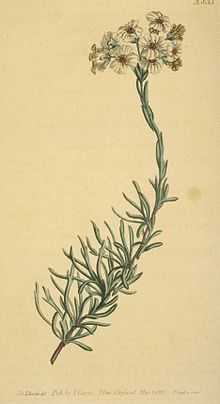Eriocephalus africanus
| Cape snow bush | |
|---|---|
 | |
| Scientific classification | |
| Kingdom: | Plantae |
| (unranked): | Angiosperms |
| (unranked): | Eudicots |
| (unranked): | Asterids |
| Order: | Asterales |
| Family: | Asteraceae |
| Genus: | Eriocephalus |
| Species: | Eriocephalus africanus |
| Binomial name | |
| Eriocephalus africanus L. | |


Eriocephalus africanus is a bushy shrublet indigenous to South Africa. It has a wide distribution in the Western and Eastern Cape, and in Namaqualand. The plant has several common names in various languages. It is known as the Cape Snow Bush or Kapokbossie (the Afrikaans word for "snow bush"); other common names refer to its fancied resemblance to rosemary, for example "African rosemary" or "Wild rosemary" (Afrikaans "(wilde) roosmaryn"). The superficial resemblance is in the foliage, which, though softer and not glossy, grows in a habit similar to that of the common Mediterranean rosemary, although the two species are not related.
Eriocephalus africanus is fragrant, with lightly felted foliage that gives the plant a matt silvery appearance. The inflorescences are small brown and pale yellow heads borne in corymbs; typically a head bears over a dozen bisexual disk florets with abortive ovaries and snowy white petals that practically cover a bush in flower. The disk florets surround usually some four to eight female florets in the centre.[1]
Ecologically the plant is important to many insects as a source of nectar and pollen, and as a minor browse to flocks and antelope. Essential oil derived from E. africanus is used as an ingredient in medicinal and perfume products. The plant has been used in traditional medicine and in cooking.[2]
Essential oil
Essential oil extracts of E. africanus are prepared by steam distillation, and contain the following primary aroma components:
- linalyl acetate 18.0%
- 1,8-cineole 4.3%
- para-cymene 3.5%
- camphene 2.8%
- linalool 2.5%
- camphor 2.4%
- sabinene 2.3%
- α-copaene 1.8%
- limonene 1.1%
- geranyl acetate 0.9%
- terpinen-4-ol 0.9%
- α-pinene 0.8%
- valencene 0.8%
- β-pinene 0.7%
- α-terpineol 0.6%
- β-caryophyllene 0.5%
- myrcene 0.2%
References
- ↑ Dyer, R. Allen, The Genera of Southern African Flowering Plants”. ISBN 0 621 02854 1, 1975
- ↑ Watt, John Mitchell; Breyer-Brandwijk, Maria Gerdina: The Medicinal and Poisonous Plants of Southern and Eastern Africa 2nd ed Pub. E & S Livingstone 1962